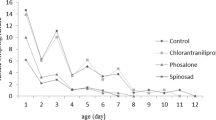Abstract
Thiacloprid, a new chloronicotinyl insecticide, is targeted chiefly to control aphid pest species in orchards and vegetables. In a standard IOBC glass plate assay, residues of thiacloprid (SC 480) severely affected adult stages of the cereal aphid parasitoid Aphidius rhopalosiphi whereas pre-imaginal stages (which develop within the host) remained unaffected. As for A. rhopalosiphi, the pre-imaginal stages of the crop-relevant egg parasitoid T. cacoeciae were not adversely affected by a spray treatment with thiacloprid (SC 480). However, when treated host eggs were stored under greenhouse conditions, the emergence success of ecdysed parasitoids was significantly reduced. This is assumed to be caused by thiacloprid residues that had been deposited on the host egg cuticle during spray treatment and which were ingested by the parasitoids during emergence, when they were biting its way through the host egg cuticle. In contrast, if treated host eggs were subjected to field exposure conditions before emergence of the parasitoids, no statistically significant reduction in emergence success was recorded. Moreover, the fitness of parasitoids emerging from treated host eggs was not reduced compared to untreated parasitoids. Since pre-imaginal stages comprise a major part of a parasitoid population and were not affected in a lethal or sublethal way by thiacloprid (SC 480), we conclude that a spray treatment with thiacloprid (SC 480) in the field will not significantly interfere with the pest control function of a parasitoid fauna in the target crops.
Similar content being viewed by others
References
Atkinson, R. (1985). Kinetics and mechanism of the gas phase: Reactions of the hydroxyl radical with organic compounds under atmospheric conditions. Chemical Reviews 85, 69-201
Burth, U. and Freier, R. (1996). Zur Entwicklung von Inhalt und Begriff des integrierten Pflanzenschutzes. Nachrichtenblatt des Deutschen Pflanzenschutzdienstes 49, 111-5.
Dickler, E. (1993). Der integrierte Obstbau in Europa. Obstbau Weinbau 30, 331-3.
Finlayson-Pitts, B.J. and Pitts, J.N. (1986). Atmospheric Chemistry. New York: John Wiley & Sons.
Hassan, S.A. (1985). Standard methods to test the side-effects of pesticides on natural enemies of insects and mites developed by the IOBC/WPRS working group “Pesticides and Beneficial Organisms.” Bulletin OEPP/EPPO Bulletin 15, 214-55.
Hassan, S.A. and Rost, W.M. (1993). Massenzucht und Anwendung von Trichogramma: 13. Optimierung des Einsatzes zur Bekämpfung des Apfelwicklers Cydia pomonella v L. und des Apfelschalenwicklers Adoxophyes orana F.R. Gesunde Pflanzen 8, 296-300.
Jaworska, K., Olszak, R.W. and Zajac, R.Z.(1996). Taux de parasitisme des larves de psylles du poirier (Cacopsylla pyri (L.)) dans des vergers avec une lutte chimique differeant en intensite. International Conference on Integrated Fruit Production. Proceedings of the meeting at Cedzyna, Poland, 28 August-2 September 1995.
Mead-Briggs, M.A. (1992). A laboratory method for evaluating the side-effects of pesticides on the cereal aphid parasitoid Aphidius rhopalosiphi (DeStefani-Perez). Aspects of Applied Biology 31, 179-89.
Meylan, W. and Howard, P. (1988-1994). Atmospheric Oxidation Program for Microsoft Windows 3.1, Version 1.55a. Syracuse Research Corp., Syracuse, New York.
Minks, A.K. (1997). Bekampfung von Lepidopterenschädlingen in Apfelkulturen durch Paarungsstörung mit Sexualpheromon. Nachrichtenblatt des Deutschen Pflanzenschutzdienstes 49, 111-5.
Pacala, S.W., Hassell, M.P. and May, R.M. (1990). Host-parasitoid associations in patchy environments. Nature 344 (6262), 150-3.
Rosenheim, J.A. (1998). Higher-order predators and the regulation of insect herbivore populations. Annual Review of Entomology 43, 421-47
Schuld, M. and Schmuck, R. (1997). Auswirkungen des Chloronicotinyl-Insektizids Imidacloprid auf die Parasitoidenfauna in Obstanlagen. Mitteilungen der Deutschen Gesellschaft für Allgemeine und Angewandte Entomologie 11, 265-70.
Vogt, H. (1995). Freilassung, Forderung und Schonung von Nützlingen im integrierten Obstbau. Mitteilungen der Deutschen Gesellschaft für Allgemeine und Angewandte Entomologie 10, 173-82.
Author information
Authors and Affiliations
Rights and permissions
About this article
Cite this article
Schuld, M., Schmuck, R. Effects of Thiacloprid, a New Chloronicotinyl Insecticide, On the Egg Parasitoid Trichogramma cacaoeciae. Ecotoxicology 9, 197–205 (2000). https://doi.org/10.1023/A:1008994705074
Issue Date:
DOI: https://doi.org/10.1023/A:1008994705074



